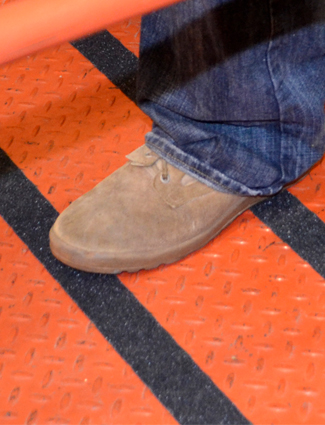Resource Navigation
Virtual Reality Aids in Slip, Trip, Fall Prevention
03
February,
2023
2 MINUTE READ

To get a feel for walking in unfamiliar and unusual environments, Savannah River Remediation is giving its employees a boost in safety training. The liquid waste contractor wants workers to get a feel for walking in a variety of environments as is using virtual reality to help prevent slips, trips, and falls (STFs). Tripping and slipping hazards are common in any industry, and there are measures to prevent these injuries that benefit younger and older workers alike.
A Hazardous Reality

STFs can happen at any time to any worker and can result in disability or death. In general industry, STFs cause 15% of all accidental deaths, according to the Occupational Safety and Health Administration. The majority of falls typically happen on the same footing level resulting from slips and trips. According to the Bureau of Labor and Statistics, in 2016 there were 849 injuries from slips, trips, and falls. These injuries were the result of improper ladder use and general walking on regular or slippery surfaces among other workplace hazards.
"Virtually all falling incidents occur while walking, which is something we all do no matter our job title," said Patricia Allen, Savannah River's director for Environmental Safety and Health. "At Savannah River Remediation, we have a mantra that ?Walking is Working,' and this virtual reality training is supporting that truth."
In Savannah River's virtual reality training, users wear a headpiece with goggles, foot and belt sensors, and hold hand controllers while "walking" through unfamiliar and unusual simulations that include a tank area of a farm and an administrative area parking lot. Workers then virtually navigate through these scenarios to avoid safety hazards such as piping on the ground or low-hanging infrastructure. Workers in this training can identify hazardous materials and choose what to do for safety and health. Allen said workers using the virtual reality system earn points for eliminating hazards.
"Most importantly, employees are learning how to traverse our hazardous working environments before even stepping foot in our real facilities," she said. Allen also said that Savannah River is looking into expanding its virtual reality program to train workers on other job task safety such as crane operations.
Finding a Balance in Training
A significant key to prevention of STFs is approaching safety with multifactor visual management leadership that encourages workers to take control of their safety. Safety managers can develop plans for preventing a range of STFs for indoor and outdoor environments as well as areas that can change frequently by conducting a facility safety audit. Employers can use simple cost-effective environmental modifications through slip, trip, and fall mitigation techniques. Alert workers to common STF hazards to boost employee recognition and awareness of potentially dangerous situations.
RELATED RESOURCES

SAIF Leader Rises to Construction Challenges
Knowing she's making a difference in the lives of workers is what motivates Melissa Diede. The senior safety ...
Read
Can Near-Miss Reporting Help Your Safety Program?
A near-miss reporting plan helps build a strong overall safety plan by reflecting on near misses and using ...
Read
Workplace Safety During the Coronavirus Pandemic
Workplaces and their employees can stay on top of coronavirus prevention and potential spreading through ...
Read.png)


